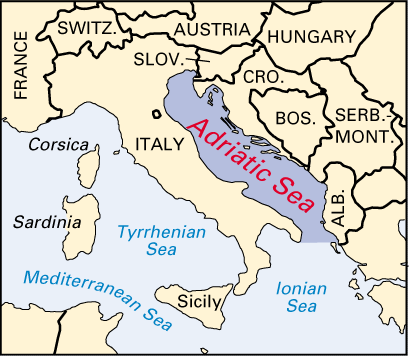Fault under Adriatic Sea might bring Italy into contact with Croatia
 Washington, Jan 27: A new study has identified a fault running under the Adriatic Sea, which could bring Italy into contact with Croatia by closing up the sea in about 50 to 70 million years.
Washington, Jan 27: A new study has identified a fault running under the Adriatic Sea, which could bring Italy into contact with Croatia by closing up the sea in about 50 to 70 million years.
The new fault spans at least 124 miles (200 kilometers) along the seafloor northwest of Dubrovnik in southern Croatia.
It runs under the Dalmatians, which consist of 1,185 islands off Croatia's coast.
According to a report in National Geographic News, this fault is helping to build more of Croatia's Dalmatian Islands and is also bulking up the Dinaric Alps – a 645 kilometre long mountain chain.
Both the islands and the mountain chain—which runs along the upper western coast of the Balkan Peninsula—were believed to have stopped growing 20 million to 30 million years ago.
But scientists found that at the new fault, the leading edge of the Eurasian tectonic plate is sliding over the South Adria microplate.
"The southern Adria microplate is covered by a thick layer of buoyant rocks called carbonates," said lead researcher Richard A. Bennett of the University of Arizona in Tucson.
"As the Adria plate moves northeast toward Europe, the carbonate layer is scraped off of the microplate, much like snow in front of a snowplow," he added.
Carbonates get piled up on the seafloor in front of the moving plate, forming new islands. Over millions of years, the islands are squeezed together like folds in an accordion, which creates new additions to the nearby Dinaric Alps.
The fault is also causing the southern "boot heel" shaped area of Italy to move toward the Croatian coast at a rate of about 0.16 inch
(0.4 centimeter) a year, while the Adriatic seafloor is sliding under Croatia.
"If this process continues, eventually the seafloor will be completely consumed, bringing Italy into contact with Croatia," said Bennett.
This scenario means the Adriatic Sea could close up in about 50 million to 70 million years.
According to scientists, the new finding should be considered when gauging the region's earthquake and tsunami potential.
"All indications are that the fault could produce a very large earthquake, but additional research is required to confirm this result," said Bennett.
"If the fault is capable of producing very large earthquakes, it could also be capable of generating a tsunami, because the fault is underwater," he added. (ANI)